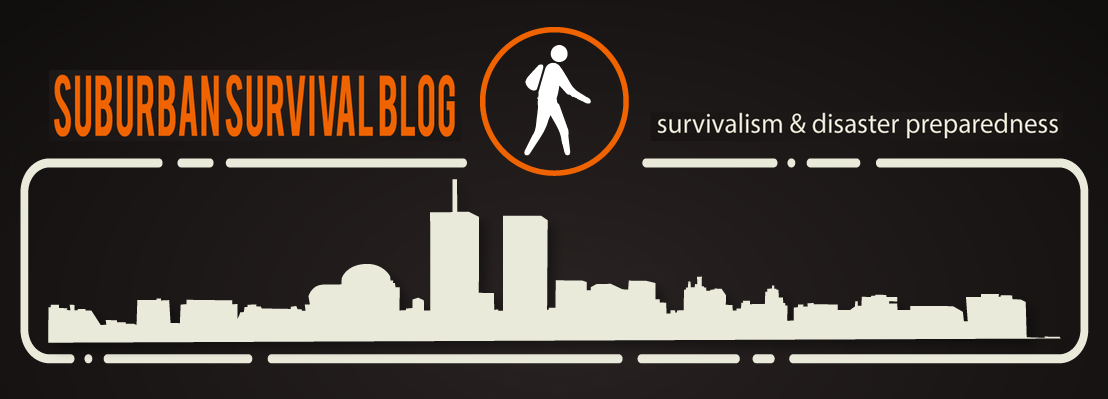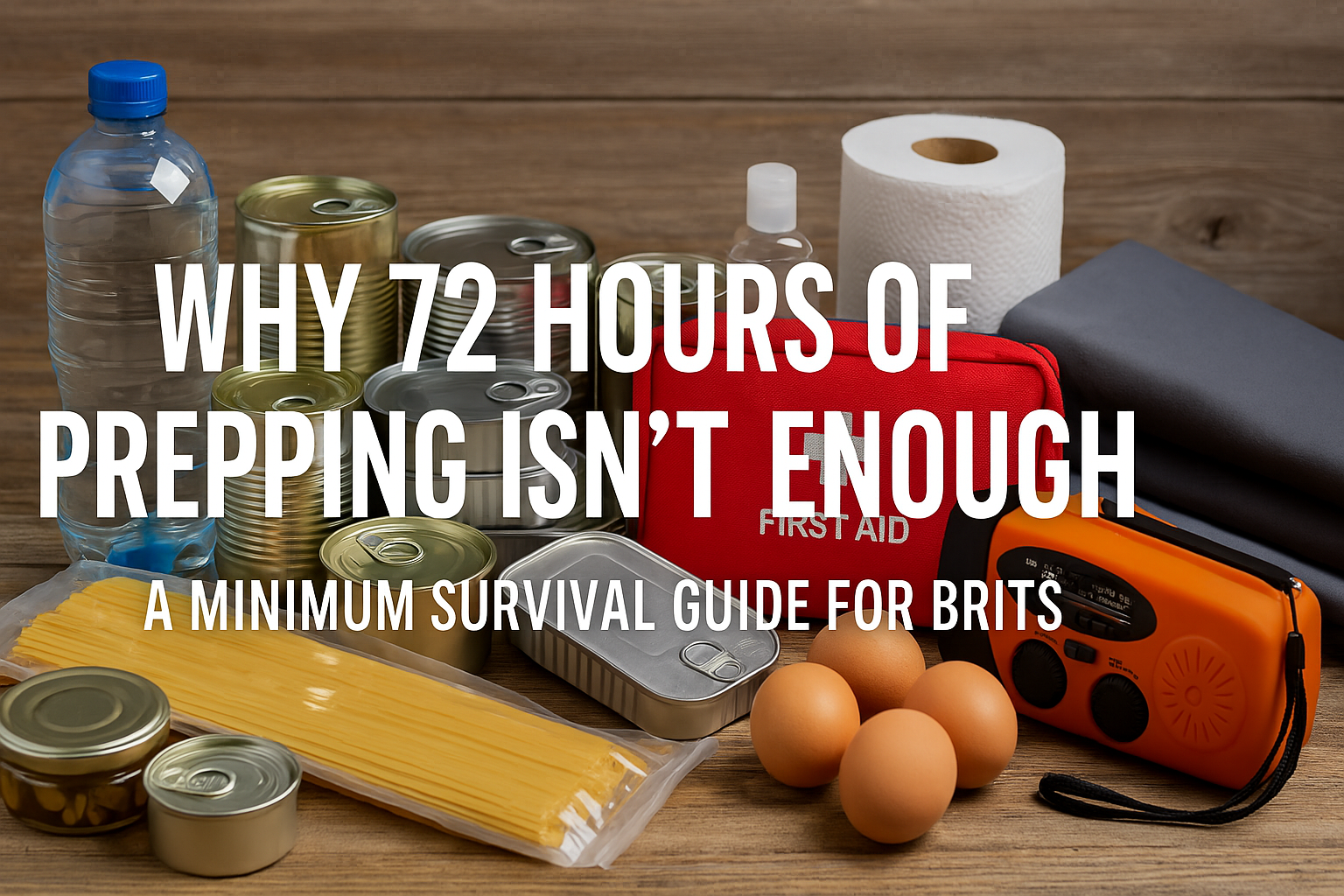Recently I gave a presentation to a group of new to seasoned preppers, clearly in various stages of their preparedness journeys. For some in the presentation, each stage of understanding was a little overwhelming because there was so much to think about. For others, they had very specific questions about areas they had a specific interest in. I noted that on more than one occasion bugging out and sheltering in were of particular interest, hence the birth of this blog post. It is essentially written for those who do not have or cannot currently afford a bug-out location in the event they have to get out of dodge prior to or during a SHTF situation. And, while I know this will not apply directly to everyone who attended the presentation, this is for you so you can think creatively about where you live, when and where you may want to go if the emergency situation dictates it. That said, let’s go…
When the unexpected strikes and society’s fabric unravels, having a bug-out location (BOL) is not just a retreat—it’s a necessity for survival. A BOL is more than just a place to escape the chaos; it’s a bastion of safety, a stronghold where one can wait out the storm. It’s a property strategically chosen to maximize your chances of enduring critical situations that force you to leave your primary residence. The selection of a BOL is a meticulous process, one that requires careful consideration of several key factors to ensure that, when the time comes, your haven stands as an impenetrable fortress against the uncertainties of a world in disarray.
Selecting the Ideal Bug Out Location: A Checklist for Survival
- Proximity and Isolation: Your BOL should be nestled far enough from urban centers to avoid the masses, yet at a reasonable distance that considers potential fuel shortages. An ideal location is one that’s off the beaten path, shrouded in nature’s cloak, offering seclusion and minimal visibility to keep hostile encounters at bay.
- Water and Self-Sufficiency: Water is the lifeblood of any shelter. Ensuring a reliable water source is indispensable for survival, necessitating storage and purification solutions. Self-sufficiency is paramount, with independent power sources like solar panels, and provisions for gardening and livestock to sustain for extended periods.
- Structure and Security: The BOL must be a solid structure, a sanctuary against the elements and potential disasters. It should offer ample space for your family, food, and water, with security measures such as natural barriers and strategic camouflage to elude detection. Always have a plan for perimeter defense and emergency exits to avoid being cornered.
Navigating Legalities and Longevity
- Natural Disaster Protection and Familiarity: Select a location with minimal risk of natural threats, one that can withstand earthquakes, floods, or wildfires. Familiarity with the terrain is vital, as it can provide a home-field advantage in times of crisis.
- Affordability and Legal Considerations: Balance the cost of acquisition and development with your budget, focusing on essential features without compromising quality. It’s crucial to understand the legalities—zoning requirements, permits, and government regulations—to ensure your BOL’s development is unimpeded by legal hurdles.
In our journey of preparedness, we understand that bugging out is not a leisurely escape but a strategic move for survival. The groundwork we lay today in selecting the right BOL is the bedrock upon which we can build a future, even when faced with the unthinkable. With these considerations in mind, we move forward, not with fear, but with the confidence that comes from thorough, informed planning.
Proceed with Caution, You May Not be the Only Ones Thinking Like This
As we delve into the process of bugging out, it’s crucial to proceed with caution. The very attributes that make a location seem perfect for your bug-out plans might also attract others with the same idea during emergencies or societal collapse. Here are essential considerations to ensure your bug-out location (BOL) remains a safe haven:
- Scout for Uniqueness and Seclusion:
- Choose a BOL with unique features that may deter others; perhaps it’s the challenging terrain or a hidden entrance that makes it less obvious.
- Ensure the BOL is at an appropriate distance from urban centers to avoid the chaos of a mass exodus, yet accessible considering potential gas shortages during emergencies. Proximity to urban areas should be balanced with the need for isolation to reduce the likelihood of unwanted encounters.
- Water and Self-Sufficiency:
- A reliable water source is indispensable. Opt for a property with a natural water source or near a pond, and remember to consider seasonal variations that may affect water availability.
- Implement self-sufficiency measures, such as solar panels, and plan for gardening and livestock to sustain for extended periods. A BOL should ideally have at least two water sources and the capability to grow a garden for ongoing nourishment.
- Defense and Longevity:
- Security measures are non-negotiable. Elevated ground, natural barriers, and camouflage can help avoid detection and prevent ambushes. Additionally, consider safety and defense measures, such as vantage points and defensive structures.
- Plan for the longest possible stay within your budget, accounting for food, water, and fuel requirements, and adapt to sustainable options over time. Maintain a stockpile at your BOL focusing on long shelf-life and non-perishable foods.
Remember, having more than one BOL is advised due to unpredictable disasters and issues like road closures, theft, or inaccessibility. Visit your BOL in all seasons to understand the climate and ensure accessibility during different times of the year. And lastly, protect your retreat by blocking most entry points, setting up perimeter defenses, and creating booby traps to safeguard against unwelcome visitors.
By considering these aspects, we can fortify our BOLs, ensuring that when we need to bug out, we have a secure and sustainable location that will provide shelter and safety during the most critical times.
Hunting Camps
In the realm of bugging out, hunting camps emerge as a top-tier choice for a multitude of reasons. Here’s why these remote sanctuaries can serve as your ultimate survival retreat:
- Abundance of Water Sources: Hunting camps are often blessed with a variety of water sources. From ponds to wells, and sometimes even swimming pools, these camps ensure that you have access to water for all critical needs—drinking, cooking, and hygiene. It’s essential, however, to have a plan for water purification to guarantee safety and sustainability (Urban Survival Site).
- Self-Sufficiency and Food Security:
- Non-Perishable Food Storage: Stock up on canned goods, grains, and other non-perishables that have a long shelf life.
- Agriculture and Livestock: A small garden can yield fresh produce, and selecting suitable livestock for the property can provide a continuous food source. Researching the best options for your specific climate and terrain is key (Cheaper Than Dirt Blog).
- Security and Defense:
- Strategic Location: Ideally, your hunting camp should be concealed from main roads and challenging to access, adding to its security.
- Buildings and Shelter: Multiple buildings can accommodate your group and provide necessary storage for supplies.
- Energy and Cooking: Propane tanks are vital for heating and cooking, with alternatives like charcoal grills and emergency stoves as backups.
- Protection: Firearms are a staple in hunting camps, not only for hunting but also for defense. Ammunition storage becomes equally crucial.
- Fortifications: Enhance your camp’s security with perimeter fencing, hidden cameras, and reinforced windows and doors to safeguard against any threats (Off Grid Survival).
Moreover, while hunting camps score high on the survival index with an impressive 86 out of 100, it’s imperative to acknowledge the challenges they might present. The journey to such a camp requires meticulous planning, considering the terrain, weather, and distance. Permissions and legal rights to the land are non-negotiable—ensure you have the right to use the camp as your bug-out location. Take into account the potential limitations, such as the absence of nearby medical facilities or limited communication options. Always conduct a thorough evaluation based on your preparedness level and individual needs to determine if a hunting camp is the right fit for your bugging-out strategy.
Abandoned Warehouses or Commercial Facilities
In the quest for the ideal ‘bug out’ location, abandoned warehouses or commercial facilities present a unique opportunity. These structures, often overlooked, can provide a wealth of resources for the savvy prepper. Here’s how we can transform these forgotten spaces into a secure refuge when bugging out:
-
- Structural Integrity and Safety: Before we claim an abandoned warehouse as our temporary shelter, our first step is to assess its structural safety. We must check for signs of damage or decay that could compromise our safety during our stay. This involves inspecting the foundation, walls, and roof for stability, ensuring the building can serve as a reliable haven (City Prepping).
- Strategic Positioning and Perimeter Security:
-
-
- Location: Opt for a one-story building that’s out in the open, away from major traffic routes or areas prone to attack. A less conspicuous location minimizes the chances of unwelcome encounters.
- Securing Entry Points: Once the building is deemed safe, we must secure all doors and windows. Locks should be reinforced, and any broken windows or doors can be blocked off with boards or sturdy furniture to prevent unauthorized access.
-
- Setting Up Camp and Resource Utilization:
-
-
- Camp Setup: Establish a small, well-insulated room near an exit to serve as our camp. This strategic placement allows for a quick evacuation if necessary, while blankets and other insulating materials around doors and windows help retain warmth.
- Water and Food Supplies: We’ll need to locate and secure water sources – checking water heaters and outside sources, as well as any remaining facilities within the building. For food supplies, pantries or any storage areas in commercial buildings may still house non-perishable items that can be crucial for our survival.
- Fire Safety: Caution is paramount when considering building a fire inside due to the risk of gas leaks and flammable materials. Always have a fire extinguisher on hand and ensure proper ventilation to prevent carbon monoxide buildup.
-
- Emergency Preparedness and Exit Strategies:
-
- Escape Plan: It’s critical that we have a well-rehearsed plan of escape. We must be familiar with all exits and establish a rendezvous point outside the building to regroup in case of an emergency evacuation.
- Adaptability: Our ability to adapt these spaces for survival is exemplified in scenarios like those shown in “Camping in Alaska’s Deepest Snow with a Dugout Survival Shelter”. These strategies, such as digging into the snow for insulation, demonstrate the ingenuity required to survive harsh conditions (Outdoor Boys).
By applying these principles, we can effectively repurpose an abandoned warehouse or commercial facility into a secure ‘bug out’ location. As we continue our journey in disaster preparedness, it’s essential to evaluate and adapt to the resources at hand, ensuring our survival in the face of adversity (Survival Dispatch).
Utility Easements
In the context of bugging out, understanding the intricacies of utility easements is crucial. These areas are designated for the installation and maintenance of essential services, and they come with specific regulations that impact how the land can be used:
- Right-of-Way Regulations: Utility easements are rights-of-way for companies to manage services like power lines or sewage systems. It’s important to remember that these strips of land are kept clear of obstructions to provide utility companies access when needed. Building or planting in these areas is not advisable as it may lead to demolition or damage by the utility company for access or maintenance purposes. Homeowners must be aware of local regulations regarding easements, as they can vary significantly (Your Guide to Property Easements).
- Emergency Access and Considerations:
- Utility easements can be strategically advantageous as they may serve as emergency access points to your property. This alternative route can be invaluable when primary roads are compromised.
- Before making any alterations to these areas, it is essential to dial 811, the universal number in the US for public utility location services, to avoid damaging underground utilities. For more comprehensive detection on private property, services like SoftDig provide private utility locating with advanced equipment such as ground-penetrating radar (Understanding Easements).
- Planning Your Bug Out Location:
- When scouting for your bug-out location, consider the implications of utility easements. They can affect property usage, limit construction plans, and offer both challenges and advantages for emergency preparedness.
- Investigate the presence of utility easements on the property and understand the regulations that govern them. This knowledge is essential for ensuring that your bug out strategies are not only effective but also legal and practical (Inside a Prepper’s Bug Out Property).
By incorporating these considerations into our disaster preparedness plans, we can ensure that our bug out shelters are not only secure but also compliant with necessary regulations, thereby enhancing our long-term safety and sustainability.
State and National Parks
In our pursuit of the perfect bug-out location, we cannot overlook the potential of national parks. These treasured reserves are not only a testament to the beauty and diversity of our natural world but also serve as a critical component in our nation’s disaster preparedness strategy. Here’s a closer look at why these areas are invaluable:
- Preservation and Protection: National parks like Glacier National Park in Montana are guardians of our natural and cultural heritage. They safeguard everything from majestic mountain landscapes and delicate ecosystems to Native cliff dwellings and expansive underground caves. In these protected spaces, we find solace and a connection to our planet’s past and future, reminding us of the importance of preserving these areas for generations to come (Sierra Club).
- Economic and Ecological Significance:
- The U.S. National Park System encompasses 425 official units across the nation, contributing significantly to the economy by generating $41.7 billion in 2019 and supporting over 340,000 jobs. This economic impact is a testament to their role in fostering not only environmental stewardship but also sustainable economic growth (Greentumble).
- As we face the daunting challenges of climate change and biodiversity loss, national parks are at the forefront of the battle. The ambitious 30x30 goal set in the United States aims to preserve 30% of lands and waters by 2030. National parks are pivotal in achieving this target, protecting vital ecosystems and endangered species like Yellowstone’s grizzly bears and the California condor in Redwood National Park.
- Community and Health Benefits:
- National parks offer more than just a bug out shelter; they provide a space for outdoor recreation and community infrastructure improvement. Studies have shown that access to green spaces can lead to reduced crime rates and improved overall health and happiness. In emergencies, these parks can become sanctuaries that not only offer refuge but also promote well-being during times of distress.
- It’s crucial to recognize the complex relationship between national parks and Indigenous peoples. Efforts are underway to preserve Indigenous culture within these parks, ensuring that the rights and traditions of these communities are respected and integrated into the stewardship of these lands.
As we consider our options for bugging out, we must acknowledge the dual role of national parks: as a potential refuge in times of crisis and as an essential element of our nation’s environmental and cultural legacy. With their blend of ecological diversity, economic vitality, and social benefits, these parks are more than just scenic backdrops; they are active players in our emergency preparedness and disaster resilience efforts.
Campgrounds
In our ongoing quest for disaster preparedness, we’ve identified campgrounds as potential bug out locations, thanks to their existing infrastructure which can be a boon in emergency situations. Here’s how to make the most of these facilities:
- Infrastructure Advantages: Campgrounds typically come equipped with essential amenities that can be life-saving in a crisis. We’re talking about water sources, first aid supplies, and temporary shelters like cabins or RV hookups. These can provide a level of comfort and security when bugging out, giving us a head start in setting up a sustainable living space (Reddit discussion on bug-out locations).
- Strategic Selection: When we’re considering a campground for our bug out strategy, we must evaluate:
- Distance and Seclusion: How far is it from our current location? Is it isolated enough to avoid large groups of people?
- Resources: Is there access to medical care and means of communication? Are there sufficient water and food supplies?
- Shelter and Security: What kind of shelter options are available? How can we ensure our safety in this space?
- Natural Threats: Are there any environmental dangers we should be aware of?
- Ownership and Supplies: Who owns the campground, and what supplies are already available on-site?
- Preparation and Defense: Once we’ve selected a suitable campground, our next steps involve:
- Preparation: We need to research our chosen location thoroughly, hide supplies in advance, and create a solid emergency plan for getting there.
- Setup: Upon arrival, we must secure a reliable water source and gather firewood while being vigilant for signs of other people or predators. This is crucial for both our immediate needs and long-term survival (YouTube guide on setting up a bug-out camp).
- Defense: Establishing a defensive plan is non-negotiable. This includes identifying shooting positions and cover to protect ourselves and our group.
As we integrate campgrounds into our broader prepping mindset, we recognize the importance of personalized preparedness. It’s not just about having a bug-out location but being prepared for any changes in our normal circumstances. This means considering alternative power sources, security measures, and waste management. A reliable water source is paramount, and knowing how to decontaminate it is a major priority for any bug-out scenario. Additionally, setting up a camp kitchen and planning for defense measures are essential considerations for longer-term stays at a campground bug-out location (Survivalist Prepper on bug-out location ideas, Outdoor Life on creating a bug-out base camp).
Abandoned Mines
In the rugged terrains of the western US and the Rocky Mountains, abandoned mines whisper tales of a bygone era of mineral rushes. These relics of the 1800s, while steeped in history, come with a host of concerns for those considering them as a bug-out location:
- Historical Hazards: The early miners who carved out these underground labyrinths were not governed by today’s safety standards. As a result, many of these mines are plagued with dangers such as unstable structures, the risk of collapsing tunnels, and the ever-present threat of falling rocks. It’s a stark reminder of the importance of safety in our bugging-out endeavors (National Park Service).
- Environmental and Health Risks:
- Toxic Legacies: The earth around these mines may seep heavy metals, radiation, and acidic mine drainage, creating an environmental hazard that could compromise our health.
- Air Quality Concerns: Within the mines, the air may be thick with pollutants, lacking oxygen, or even contaminated with standing water, all of which pose serious respiratory risks. Such conditions demand not just caution but the right equipment for safe breathing (Reddit’s TheForgottenDepths).
- Preparation and Equipment: Before even setting foot near an abandoned mine, we must arm ourselves with knowledge and the right tools. Consulting local authorities and mining experts is a step we cannot afford to skip. They can provide invaluable insights into the mine’s stability and safety. When we do decide to explore further, gas detectors and structural assessment tools are non-negotiable for ensuring our safety in these unpredictable environments (Urban Survival Site).
The haunting allure of abandoned mines as a bug-out shelter must be weighed against the stark reality of their dangers. From 2000 to 2013, hundreds have lost their lives in such places, with drowning in water-filled pits and falls into mine shafts being the leading causes. The absence of clear signage and the fact that many sites are not marked at all only heighten the risk. While federal efforts are ongoing to secure these sites, the sheer number of them—estimated in the hundreds of thousands—means that many remain a perilous enigma (EPA).
Our bugging-out plans must be underpinned by rigorous risk assessment and an unwavering commitment to safety. The decision to use an abandoned mine as a bug-out location is one that requires a thorough understanding of the specific site’s risks and potential hazards, ensuring that our choices in disaster preparedness are as sound and secure as the shelter we seek.
Caves
In our continuous efforts towards disaster preparedness, caves emerge as compelling options for those of us considering effective bug-out shelters. Their natural formations offer protective structures that provide overhead cover and potential stability, crucial in survival situations. Here’s what we need to know when considering caves as a viable option:
Essential Considerations for Cave Shelters:
- Overhead Protection: Caves naturally provide protection from the elements, including moving air and sun exposure, which are critical for preventing burns, dehydration, or heat strokes. It’s essential to ensure the cave has a sturdy, waterproof roof and offers enough room for not only ourselves but also our gear.
- Sleeping Arrangements: To combat the loss of body heat and the risk of insect infestations, we should plan to have sleeping alternatives off the ground. A well-insulated sleeping bag is a must-have to ensure a warm and safe night’s rest.
- Safety Measures: Never explore caves alone; always wear a hard hat or helmet and carry multiple sources of light. Avoid narrow caves and areas with signs of animal activity. Being prepared for injury prevention and management is a key aspect of cave safety.
Equipment Checklist for Cave Exploration:
- Protective Gear: A hard hat and sturdy footwear are non-negotiable for navigating the rough terrain within caves.
- Lighting: Multiple backup lights are essential to ensure visibility in the complete darkness of underground environments.
- Apparel: Clothing for layering and gloves will protect against cold and rough surfaces, while a cave pack will carry necessary supplies.
- Survival Essentials: Food, water filters, and first aid kits should be included in our cave packs to handle emergencies.
Pre-Planning for Using Caves as Bug Out Shelters:
- Multiple Entrances: Caves with multiple entrances can provide alternative escape routes, enhancing our safety.
- Tent for Warmth: Using a tent within the cave can offer additional warmth and protection from critters.
- Environmental Survey: Before bugging out, we should research historical weather data, and geography, and conduct local surveys to ensure the cave is in a high, safe location.
- Disaster Avoidance: Knowing the history and geography of potential shelters is crucial for avoiding areas prone to natural and man-made disasters.
When setting up a shelter within a cave, proximity to a water supply, availability of trees for firewood and building shelter, game for hunting or trapping, and rocks for building a shelter or surrounding a fire are all crucial factors to consider. Additionally, we must be mindful of the surrounding trees, steering clear of those with dead branches or fruit trees that attract insects and animals.
For our long-term success in building a shelter, survival gear like solar panel backpacks, heavy-duty tarps, paracord, camp stoves, and lanterns are indispensable. Moreover, stocking up on food supplies, such as canned meats and emergency food buckets, will ensure we have the necessary provisions to sustain ourselves in our cave shelter.
By incorporating these strategies and ensuring we have the essential equipment for safety and survival, we can optimize caves as bug-out shelters, tapping into their natural defense against the elements and leveraging their seclusion for our disaster preparedness plans.
Ghost Towns
In the realm of disaster preparedness, ghost towns emerge as intriguing prospects for those of us dedicated to the concept of bugging out. These deserted settlements, often relics of a once-thriving past, can offer the seclusion and shelter necessary in times of turmoil. However, we must be meticulous in our planning to ensure these locations meet our survival needs. Even New Jersey where I live, has its share of Ghost Towns that are isolated from high-traffic areas
Here’s how to approach these historical havens:
-
- Historical Insights and Modern-Day Considerations:
- Ghost towns often have roots in industries such as mining or logging, reflecting a region’s historical economic activities. While these towns have been abandoned, many still hold remnants of their industrious past.
- Some ghost towns have been preserved as state parks, where the echoes of history are protected. These locations can be educational, but they may also come with restrictions that could limit our interaction or use of the area.
- Identifying and Accessing Ghost Towns:
- Discovering hidden ghost towns, mining camps, and logging camps requires a blend of research and exploration. We may need to employ four-wheel drive vehicles to navigate the challenging terrain that often surrounds these areas.
- To find ghost towns near us, tapping into the wisdom of older individuals in our social network or utilizing online resources, such as the comprehensive Wikipedia list of ghost towns across the United States, can be invaluable.
- Our local library can be a goldmine of information, offering books dedicated to the ghost towns within our region, providing us with a solid starting point for our search.
- Historical Insights and Modern-Day Considerations:
- Preparation for Bugging Out to a Ghost Town:
-
- When we consider bugging out to a ghost town, we must be prepared to face supply and resource limitations. Ensuring access to running water is crucial, whether it’s from natural sources in rural areas or through improvised systems in an urban setting.
- Opting for a bug-out location far from population centers can shield us from the competition for resources and potential conflict, a key factor in our emergency preparedness.
- In dire situations, we might need to venture beyond city limits to secure a suitable retreat. We’ll weigh factors like proximity to water sources, distance from densely populated areas, the viability of the ground for agriculture, and the defensibility of the location.
By thoroughly assessing these deserted towns with an eye for both their historical significance and practical potential, we can ensure that our chosen bug-out shelter is not only secluded and rich in character but also viable for our survival strategy.
The Dangers of Some of the Locations Indicated In this Blog Post
Through careful consideration and analysis, our exploration of potential bug out locations has provided a diversified portfolio of refuges, each with unique attributes and challenges. Our discourse spanned from the secluded strongholds of hunting camps and obscure ghost towns to the repurposing possibilities inherent in abandoned warehouses and the rugged allure of caves. These insights underline not only the importance of strategic selection and preparedness but also the need for adaptability and a profound understanding of the environmental, legal, and safety implications involved in each scenario.
In the end, our key takeaway is that preparedness hinges on more than simply selecting a hideaway; it requires a holistic approach that synergizes resourcefulness, legal cognizance, and environmental foresight. Whether the choice leads one to the natural fortifications of national parks, the infrastructure of campgrounds, or the solitude of rural homesteads, the best bug-out location is that which is meticulously tailored to individual needs, offering security, sustainability, and peace of mind in the face of uncertainty.
Conclusion
In the final analysis of our bugging-out strategy, we recognize the critical importance of a bug-out plan and location (BOL) as our lifeline in times of disaster. The selection and preparation of a BOL is a complex process that demands our utmost attention and effort. To ensure our survival and resilience during emergencies, we must prioritize the following elements:
- Strategic Location Selection:
-
-
- Proximity: Our BOL must be strategically positioned at a safe distance from urban centers to avoid the chaos of a mass exodus, yet remain accessible via primary and backup routes, ensuring a swift and safe relocation when necessary.
- Isolation: The ideal BOL is one that is hidden from plain sight, shielded by natural elements, and offers minimal visibility, significantly reducing the risk of hostile encounters and preserving our safety (LinkedIn’s guide to choosing the perfect BOL).
-
- Essential Features for Sustainability:
-
-
- Water and Food: A consistent and clean water source is vital; we must consider properties with natural water sources or proximity to ponds, factoring in local rainfall and seasonal variations. For food, the ability to grow our own produce and perhaps raise livestock is a cornerstone of self-sufficiency.
- Power and Waste: We aim for independence through renewable energy sources such as hydro-power or solar panels. Concurrently, a well-thought-out waste management system, including composting and designated disposal areas, is essential for maintaining health and hygiene within the BOL (Persurvive’s insights on BOL features).
-
- Preparedness and Legal Compliance:
-
- Security and Structure: Our BOL should be a fortress against the elements and potential threats, with a robust structure, perimeter security, and emergency exits. It must also stand resilient against natural disasters, with considerations for the local geography and weather patterns.
- Legalities and Longevity: We must thoroughly understand the legalities such as zoning, permits, and government regulations to ensure our BOL development proceeds without hindrance. Planning for the longest possible stay within our budget is a testament to our commitment to enduring survival (Medium’s ultimate bug out cabin guide).
In parallel to our BOL, our readiness is further enhanced by the assembly of a bug out bag — a portable kit that stands as our immediate response to an evacuation. This bag is meticulously packed with essentials such as non-perishable food, water purification means, shelter provisions, first aid supplies, and tools for navigation and communication. It’s the embodiment of our readiness to face the initial 72 hours of a disaster, ensuring our survival as we transition to our BOL (City Prepping’s guide on how to bug out).
By adhering to these guidelines, we fortify our position and enhance our chances of survival in the face of adversity. Our bugging-out strategy is not merely a plan, but a comprehensive approach that encompasses every facet of emergency preparedness, from the selection of a secure and sustainable BOL to the detailed packing of a bug-out bag. It is this meticulous and informed planning that will steer us through the storms of uncertainty and into the calm of a secure future.
FAQs
- What does bugging out mean?
- Bugging out involves leaving your current location during a crisis or disaster to seek a safer place. This proactive measure is essential when staying put poses greater risks than relocating, and it requires careful planning and swift action (Reddit preppers discussion, SunnySports survival blog).
- Essentials for a Bug Out Bag (BOB):
- A BOB is a portable kit designed to sustain you for 72 hours in an emergency. It typically includes food, water, first aid supplies, clothing, and tools necessary for survival. The purpose of the BOB is to provide immediate resources during the initial phase of bugging out, before reaching a more secure and sustainable location (Modern Warrior Project).
- Steps to Develop a Bug-Out Plan:
- Identify potential disasters specific to your region.
- Select suitable bug-out sites, including government-run shelters, relatives’ homes, or personal shelters.
- Determine bug-out routes that account for various scenarios and obstacles.
- Prepare a bug-out vehicle (BOV) that matches the needs of your evacuation plan.
- Pack a bug-out bag (BOB) with all essentials tailored to your family’s needs and the nature of the anticipated disasters.
- Considerations for Your Bug-Out Vehicle (BOV):
- Your BOV is likely the vehicle you already own. Evaluate if it’s suitable for your evacuation needs, considering factors such as size, fuel efficiency, and off-road capability. In mass evacuations, smaller, more maneuverable vehicles may be advantageous due to their ability to navigate through congested areas (Homestead Launch).
- Leveraging Reciprocity Arrangements:
- Having agreements with family members and friends in strategically located areas can provide alternative bug-out locations when chaos ensues. This network of safe havens can be crucial when primary plans are compromised, offering flexibility in an unpredictable situation (Off Grid Survival).
- Mock Bug Out Exercises:
- Practicing mock bug-out exercises can help in refining your emergency plans, ensuring that you and your family are well-prepared to execute the plan under stress. These drills can reveal gaps in your preparations and provide valuable insights for improvement.
Remember, bugging out is a temporary solution to seek immediate safety during a disaster. It differs from relocating, which is a permanent move to a new location. The ultimate goal of bugging out is to reach a secure location where you can sustain yourself and your family until it is safe to return or until a new permanent solution is found (Bug Out Survival).








